Lessons and Learning Resources
| Note: | Please
see Amathuba site for latest lecture
slides and course
handout. |
| Week 1: |
Intro to HPES and Essential Terms (first week of
term 1) |
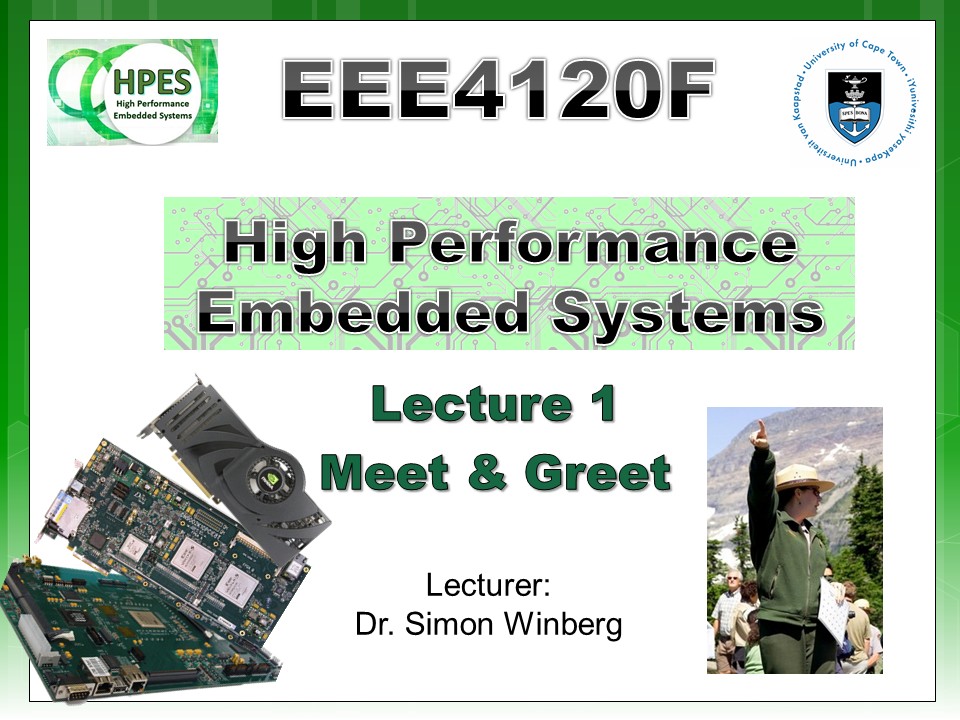 PDF
PDF |
Lecture 01 This is the first lecture for this course, mainly a Meet & Greet and explanation of how the course is structured and what is involved. Have a look though this lecture and then give Quiz0 a try..
|
 PDF PDF |
Lecture 02 Terms, Validation vs. Verification, Commonly used verification Amdahl’s Law, Dealing with reading assignments. Then discussion bridging to Prac1 and use of golden measure. Discuss reading R01.  Watch:
Linux Magazine Video: Understanding Parallel
Computing (Part 1): Amdahl's Law Watch:
Linux Magazine Video: Understanding Parallel
Computing (Part 1): Amdahl's Law Watch (optional): Understanding Parallel Computing (Part 2): The Lawn Mower Law |
| Week 2: | Towards Digital Accelerators. Benchmarking Techniques |
 PDF PDF |
Lecture 03
Links (suggested further reading or activities): |
 PDF PDF |
Lecture
04 OpenCL Overview. How to program in OpenCL. You may
want to hyperspace to slide 42 if you want to get
going with Prac2 asap. (some clickable Voice
annotations in the PowerPoint
slides updated). |
 PDF PDF
|
Lecture 05
|
| Week 3: | Parallel programming & Performance Benchmarks |
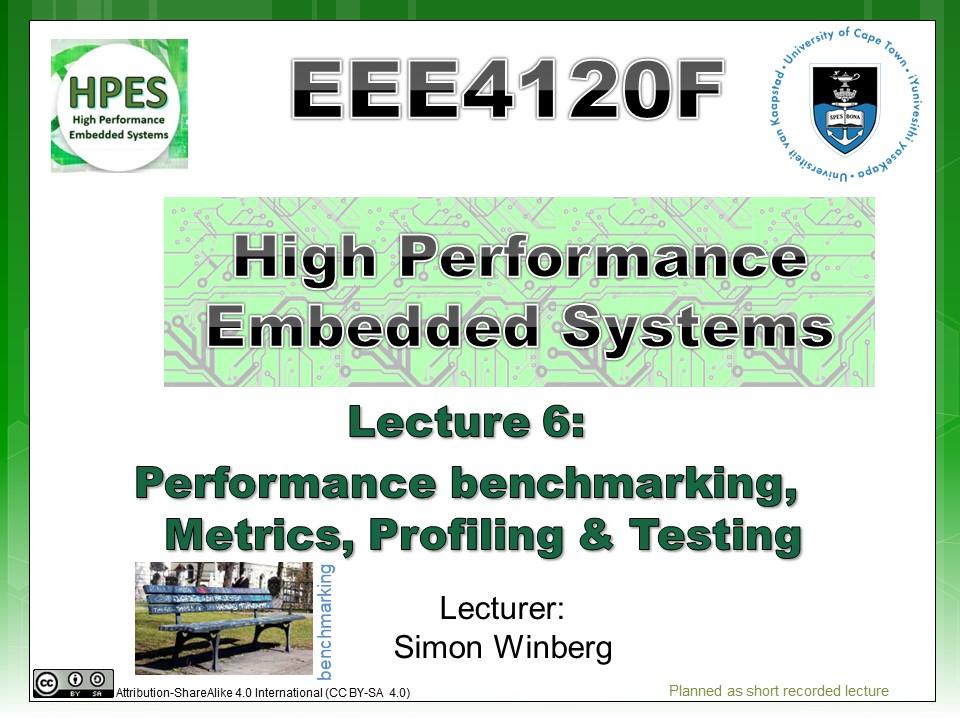 PDF PDF |
Lecture
06 Performance benchmarking (Part 2). Links (suggested further reading or activities): |
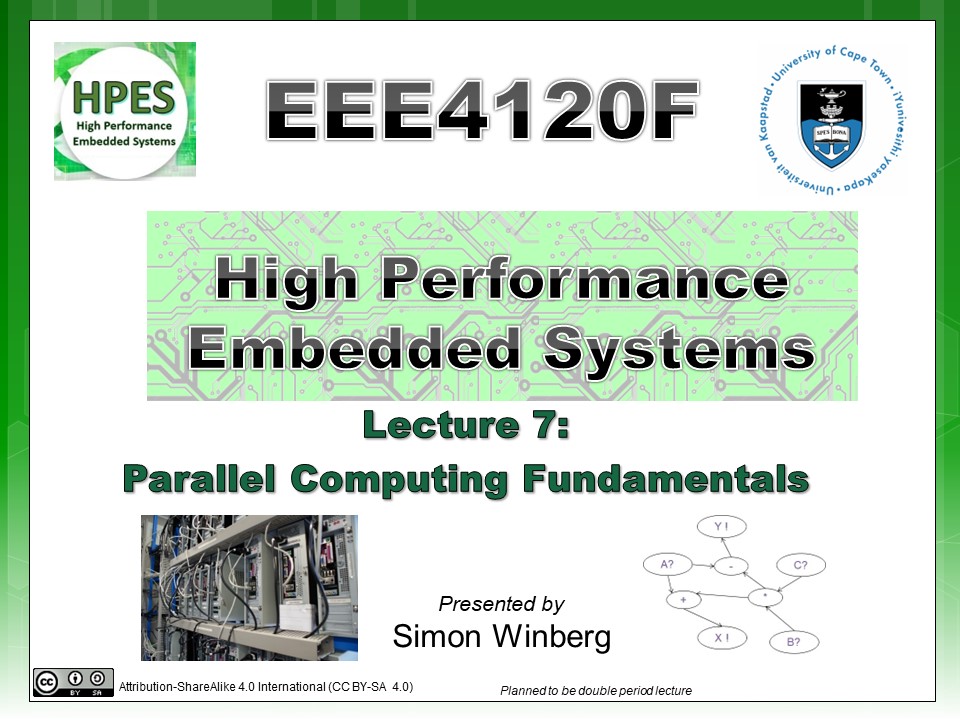 PDF PDF
|
Lecture
07 Parallel Computing Fundamentals. Large Scale Parallelism. Mainstream parallel. Classic Parallel approaches. Flynns Taxonomy. Some Calculations - effective parallelism, parallel Efficiency, Gustafson's Law. (Excel document that illustrates to the solution discussed in slides: L7-activity calc.xlsx)
|
 PDF PDF
|
Lecture
08 Amdahl's Law for the Multicore Era and Base Core Equivalents (BCE). - Understanding Amdahl's Law for the Multicore Era- Base Core Equivalents (BCEs) - Calculating performance using BCEs |
| Week 4: | Design of Parallel Systems and Programs |
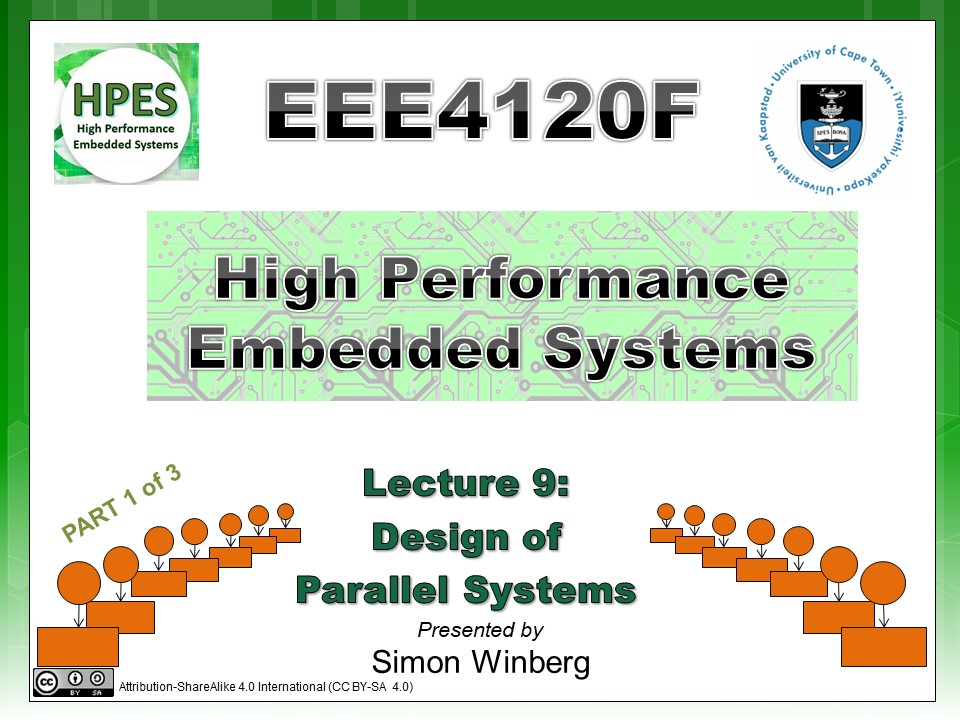 PDF PDF |
Lecture
09 Steps in parallelizing programs. Understand the problem. Partitioning. Granularity. Identify data dependencies. In these presentation covering steps 1-3: 1) Understand the problem, 2) Partitioning (i.e. separation into main tasks), 3) Granularity (assessing granularity of the problem vs. the parallelism). Note: refined description to explain the difference between 'granularity of problem' vs. 'granularity of parallelism'. (Discussion brings in issues and thinking points of GA2 Conceptual Assignment) |
 PDF PDF |
Lecture
10 Continuing the steps of designing parallel systems. Covering Steps 5-7: 5) Synchronization, 6) Load balancing, 7) Performance analysis and tuning. (Step 4 is a rather elaborate step, involving communication and integration of subsystems and is therefore covered in a lecture on its own). |
| Week 5: | Communication and Memory Architecture |
 PDF PDF
|
Lecture
11 Step 4: communication: Factors related to
Communication; Cost of communications; Latency vs.
Bandwidth; Baud rate vs. Bandwidth; Effective
bandwidth; Visibility of Communications; Synchronous
vs. asynchronous; Scope of communications;
Collective communications; Efficiency of
communications. |
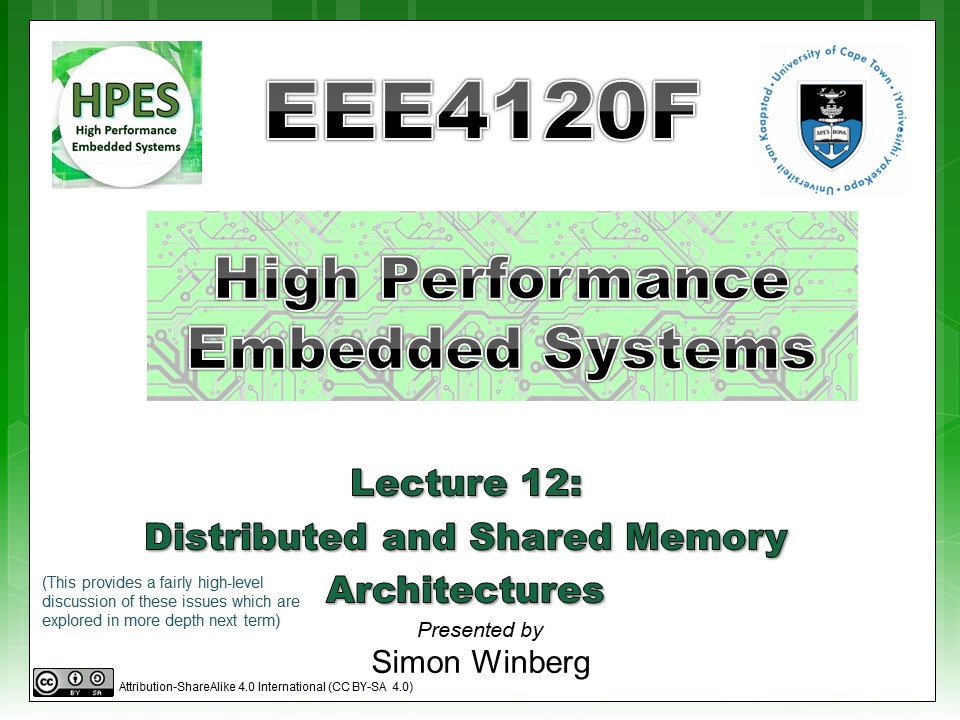 PDF PDF |
Lecture
12 Distributed and Shared Memory Architectures: Distributed memory infrastructure; Shared memory infrastructure; Hybrid memory infrastructure; Warming up for MMU, DMA and memory considerations (to be delved into next term). |
| Week 6: | Intro to YODA Project and Verilog Refresher |
 PDF PDF
|
Lecture
13 Your Own Digital Accelerator (YODA) Project;
Discussion of Digital Accelerators. |
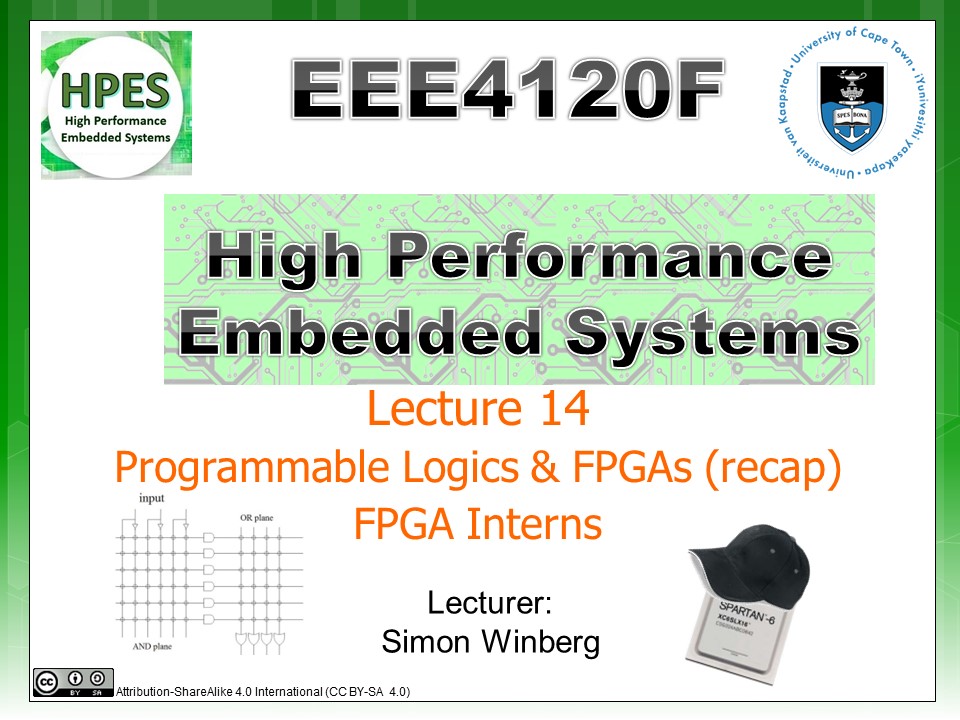 PDF PDF |
Lecture
14 Programmable Logics and FPGAs Interns. Topics covered:
|
 PDF PDF
|
Lecture
15 Coding in Verilog: Basics of Verilog coding. Exercise in Verilog. Verilog simulators. Intro to Verilog in Vivado/ISE. Test bench. Generating Verilog from Schematic Editors. (This presentation does recap various aspects covered in EEE3096S ES-II).
|
| Week 7: | Class Test. YODA Project Planning & Term 1 catch-up |
| Test 1. Progress and planing of your YODA projects. Catch up on practical assignments. | |
| Week 8: | More Verilog HDL and Simulation Techniques |
 PDF PDF |
Lecture
16 Topics include: Brief recap (of Verilog items from
lect 15); Busses and Endianness; Functions in
Verilog; Implementing state machines; Blocking and non-blocking simulation example. |
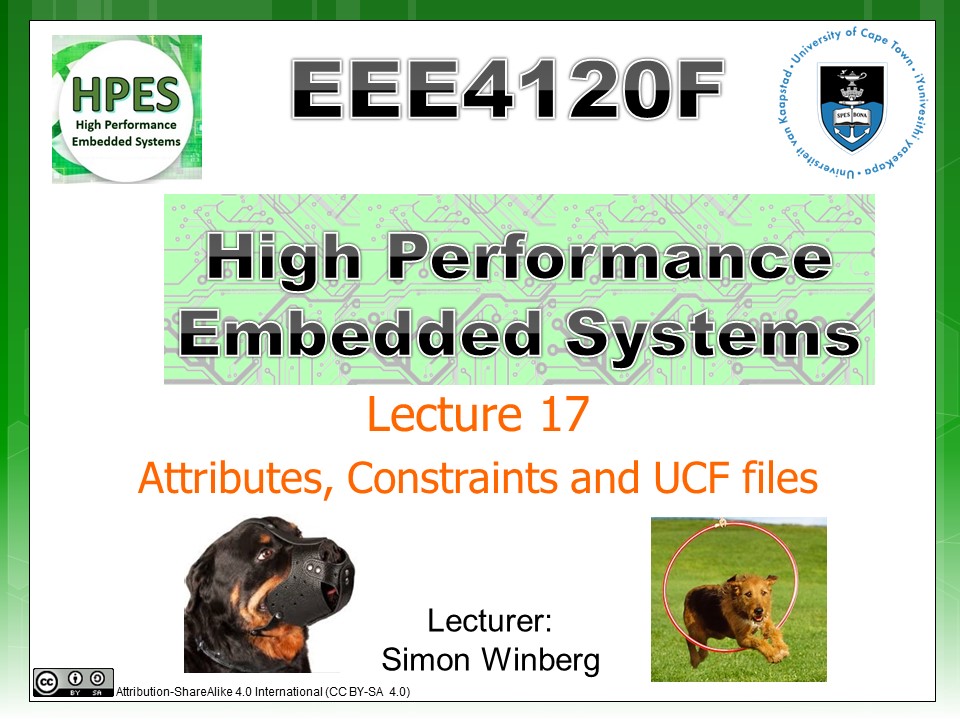 PDF PDF |
Lecture
17 Topics covered: Attributes; Constraints; UCF Files; Xilinx Design Constraints {many of these slides won't be examinable, slides relevant to exams: 4-7, don't need to know syntax for UCF (skip 8-13), be familar with what XDC is but won't be expected to know use this tool and don't need to worry with the UCF tutorial, although useful to try it if you plan to use a Xilinx FPGA board.} |
| Week 9: | FPGA systems and related architecture |
 PDF PDF
|
Lecture
18 FPGA and CPU Performance Comparison (audio
annotations in pptx). |
 PDF PDF |
Lecture
19 HDL Imitation method. Using standard benchmarks for FPGAs. Amdahl's Law for FPGAs. The 'HDL Imitation' method is a suggested approach to quickly get together both a golden measure and a start on a HDL solution. Various case studies are used in these slides for examples of how the methods are applied. |
 PDF PDF
|
Project
MS-1 Tips on strategizing your YODA projects, and deciding roles for the team members. Plans on marking and review of MS1 submission and onward to MS2 and expectations for that milestone. |
| Week 10: | Config architecture, Interconnects |
 PDF PDF |
Lecture
20 More Verilog; Configuration Architectures; RC
Building Blocks (for IP Cores); Basic handshaking,
latches and other interface ingredients. |
| Week 11: | More HDL methods; RC Design Process |
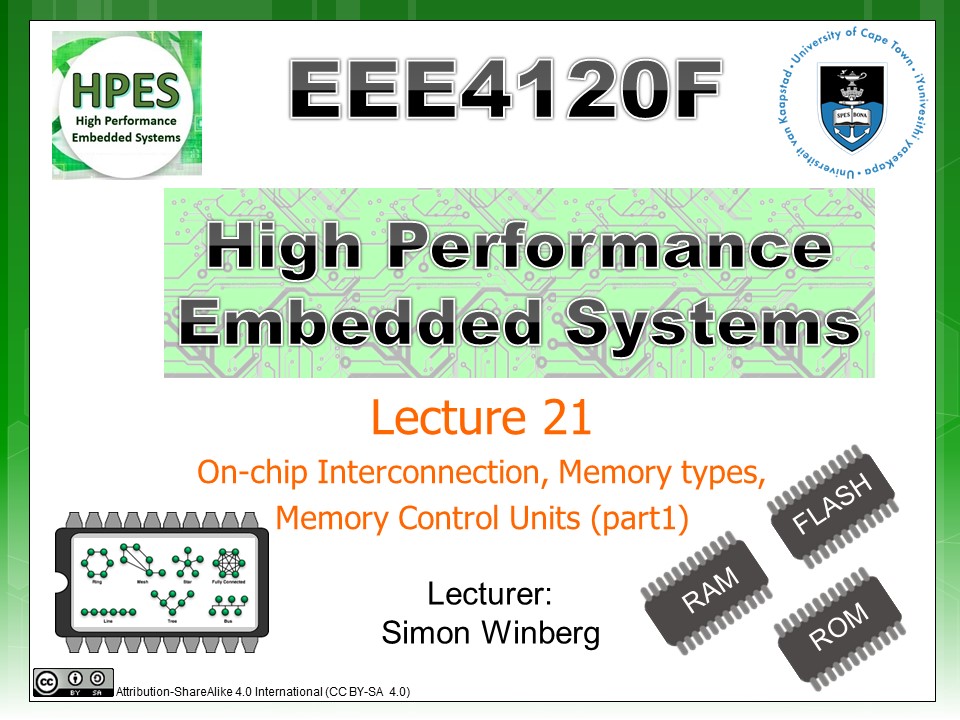 PDF PDF |
Lecture
21 On-chip interconnection bus topologies; Interfacing standards; Memory types; Memory Control Unit (MCU) (Part 1 of 2); Using Memory and MCU in Verilog Example single-port memory unit in Verilog: RAM MCU ramc.v testbench: ramc_tb.v
ramc.v testbench: ramc_tb.v |
 PDF PDF |
Lecture
22 Memory Control Units (part 2 of 2): Dual-port memory control unit, Setting up memory in code and in simulation; FIFO and LIFO. {optional reading: On-chip Interfacing Standards: Wishbone and how it works, The Altera/Intel Avalon Bus}. Example half-duplex single-port memory unit in Verilog: HDP-RAM MCU hdp_ram.v testbench: hdp_ram_tb.v
hdp_ram.v testbench: hdp_ram_tb.v Example full-duplex single-port memory unit in Verilog: FDP-RAM MCU  fdp_ram.v testbench: fdp_ram_tb.v
fdp_ram.v testbench: fdp_ram_tb.v |
| Week 12: | HPES and Reconfigurable Computing Design Process; Softcores (8-12 May) |
 PDF PDF |
Lecture
23 HPES Development Process and Management Aspects: Where work is done; Division of Labour (DoL); HPES development process; Setting system objectives; Costs and risks; Monitoring progress; Documentation; Effort, Productivity and Progress. (Indeed, design and development team factors that university graduates working on advanced embedded systems should be aware of.) (Optional extra slides re intro to Doxygen) |
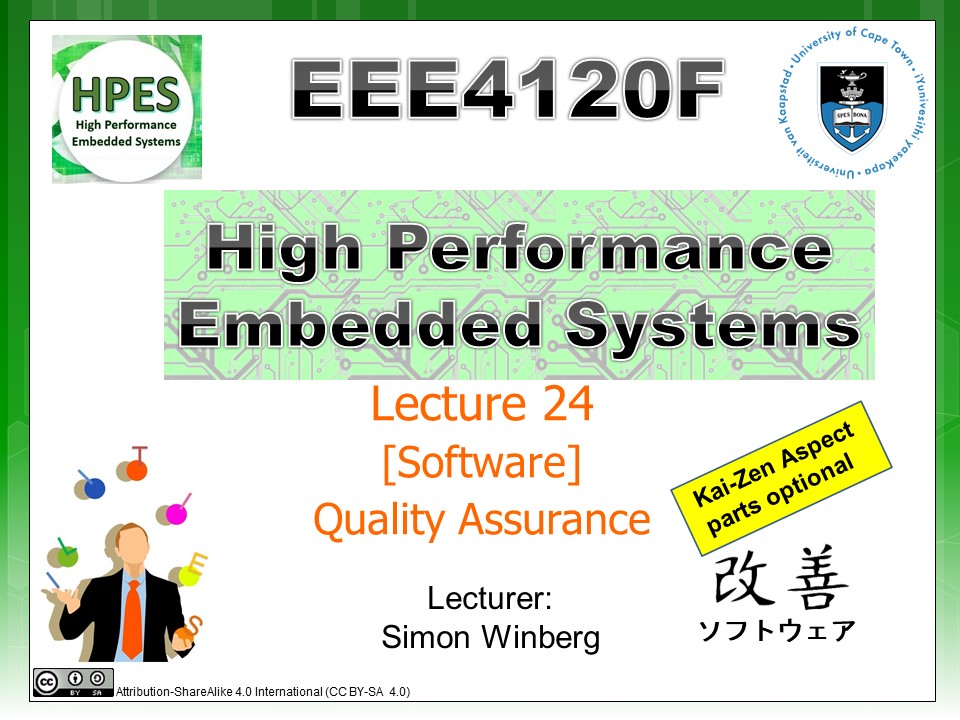 PDF PDF |
Lecture
24 Note that slide 15 onward are optional reading and will not be examined this year. Comments/study tips: '[Software] Quality Assurance'. NB: For the exam, you can skip most of this lecture, it is largely optional additional reading and will not be examined! However, as per my earlier comment, it is good for a university graduate to know about these issues. The '[software]' is in square brackets because, while much of these slides do related to software, much of the aspects also relate to HPES and FPGA-based HDL disign work. Topics: What is quality?; Software quality; Software quality assurance (SQA); Software quality systems; Consequences of bad SQA; An evolutionary model of SQA in organizations; Kaizen of software and Formal Specifications as getting closer to accurately specifying quality. |
| Summary: | Summary and study tips |
| The last lecture provides a brief summary of the main topics and discusses planing for the exam. You are most welcome to bring points that you want to ask about or aspects in the slides that you would like more clarify or practice examples provided to use for studying. |

 Read L01:
Read L01:
 Lecture2(notes).pdf
Lecture2(notes).pdf
 Code mentioned in the
slides:
Code mentioned in the
slides: